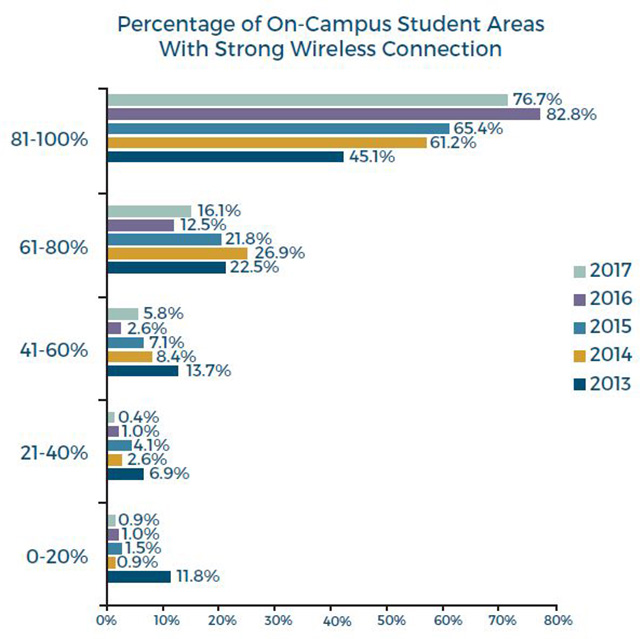Wireless Demand (and Supply) Just Keeps Going Up
It's no wonder students expect comprehensive WiFi when they come to campus. After all, that has become the "ResNet" norm on most campuses. Seventy-seven percent of colleges report WiFi throughout 81 percent to 100 percent of their campus student areas. On top of that, 70.5 percent of campuses dedicate at least a gigabit or more per student for ResNet activities; 27 percent offer as much as 7Gb or more. However, while "robust" wireless connectivity is on the rise in academic areas, there's been a slight decline in social areas.Those are some of the findings in this year's "State of the ResNet" survey done by the Association for College and University Technology Advancement (ACUTA) and Association of College and University Housing Officers-International (ACUHO-I). The annual report analyzed responses from 450 surveys representing 320 schools.
This year, comprehensive wireless coverage saw a 6 percent dip from last year's 83 percent of campuses that reported strong wireless connectivity over at least 81 percent of the campus. However, institutions saw an increase from 65 percent to 70.5 percent in the number of institutions committing at least a gigabit per student for ResNet traffic. Nearly three-fourths of campuses let residents connect an unlimited number of devices to the ResNet (a 6 percent increase from last year).
To cover the costs of this provisioned technology, more schools have increased or are considering increasing student or user tech fees. Right now, according to the report, 61 percent of schools levy a general technology fee. Forty percent of institutions have merged network services with other IT services to save on ResNet costs.
Nearly three-quarters of institutions are considering plans for "cellular augmentation" to accommodate "seamless wireless coverage," the report stated. More than seven in 10 schools (72 percent) are considering options for boosting residential cellular reception on campus, up 14 percent from last year. Among their choices: in-building DAS (referenced by 21 percent of respondents), outdoor DAS (mentioned by 15 percent) and outdoor cellular sites or towers (cited by 13.5 percent).
"Colleges and universities are amongst the most demanding wireless environments today. Over the past five years of this study, bandwidth demand by students has been increasing, and bandwidth availability and the delivery to satisfy those demands have also increased," the report stated. The main driver: Good WiFi is important in "attracting and retaining on-campus students" and keeping students happy, all of which has an impact on "the university as a whole."
Question :
1. Who often use wifi on campus ??
Who often use wifi
on campus are students
2. What percentage of high
perguruang using wifi???
Seventy-seven
percent of colleges report WiFi throughout 81 percent to 100 percent of their
campus
student areas
3. How many analyzed responses the
findings in a survey conducted by the University and Higher Technological
Advancement Association (ACUTA) and the Association of College and University-International
Nurses (ACUHO-I)???
450 surveys
representing 320 schools
4. How many percent are down from
last year
6 percent dip from
last year's
5. How to cover the cost of this set
technology??
As more schools
increase or consider raising student or current user fees
6. What percentase of schools
collect fees for this technology?
61
percent of schools charge fees for this technology
7. How many percent consider the
option to increase mobile acceptance on campus last year
14
percent of schools are considering options to increase mobile acceptance on
campus last year
8. Which environment demands to use
wifi??
The environment
that uses wifi is the school and college environment
9. Why students and students always
use wifi ??
Because wifi can
make students and students happy
10. How many percent of institutions
have combined network services with other IT services to save Resnet costs??
Forty
percent of institutions have merged network services with other IT services to
save on ResNet costs.

